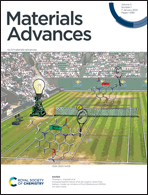Increased performance of an all-organic redox flow battery model via nitration of the [4]helicenium DMQA ion electrolyte†
Abstract
Redox flow batteries (RFBs), through their scalable design and virtually unlimited capacity, are promising candidates for large-scale energy storage. While recent advances in the development of redox-active bipolar organic molecules satisfy the prerequisites for the pioneering emergence of symmetrical all-organic redox flow batteries (SORFBs), problems of low durability or low energy density remain a bottleneck for their wide-spread application. The present work reports that nitration of the [4]helicenium dimethoxyquinacridinium (DMQA+) ion core (NO2C+) results in a significantly enhanced electrochemical performance of DMQA+ as the electrolyte for SORFBs. The physical and kinetic properties of NO2C+ were evaluated by cyclic voltammetry (CV) and UV-visible spectroscopy in acetonitrile and compared to those of its precursor (HC+). The ability for electron storage of NO2C+ was investigated in three different types of static H-cell experiments. In the first experiment, NO2C+ provided an open circuit voltage (OCV) of 2.24 V resulting in demonstrated good stability, as well as high coulombic (>98%) efficiencies, over more than 200 charge/discharge cycles. In the second experiment, a charge–discharge cycling over the entire redox window of NO2C+ (OCV > 3 V) resulted in 80 cycles at a potential energy density above 12 W h L−1. During the last experiment, a bipolarization stress-test was performed in which NO2C+ demonstrated a remarkable durability of 90 cycles at 100% load with a perfect retention of capacity and coulombic efficiency. The enhanced electrochemical performance of this redox material highlights that DMQA+ ions are robust and versatile materials for the emergence of SORFBs.
![Graphical abstract: Increased performance of an all-organic redox flow battery model via nitration of the [4]helicenium DMQA ion electrolyte](/en/Image/Get?imageInfo.ImageType=GA&imageInfo.ImageIdentifier.ManuscriptID=D1MA00914A&imageInfo.ImageIdentifier.Year=2022)


 Please wait while we load your content...
Please wait while we load your content...